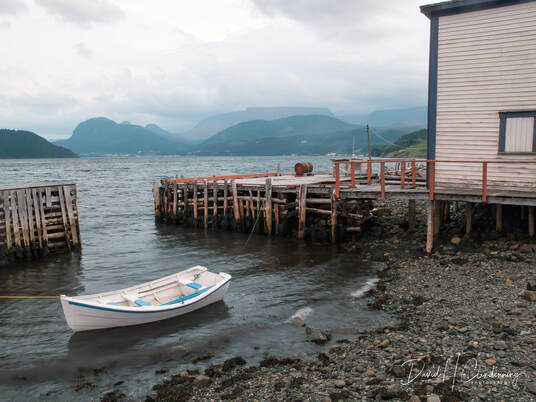Gros Morne and Northern Peninsula
Rocky Point - Gros Morne
Powerfully evocative
Tablelands
Trout River
I sat upon a rocky shore |
Quirpon Island
Two views of Quirpon Island Lighthouse, Northern Peninsula
L'Anse-aux-Meadows Viking Settlement
The Norse: Trading for Wealth and Status
For the Norse, the sharing or giving of exotic goods was an important way to display political power. The Norse trading world extended from Greenland to Baghdad. It involved the trans-shipment of luxury goods including silver, copper, tine, velvet, ivory, glass, spices, wine, weapons, and ceramics, and mundane items such as salt, flour, soapstone, iron, furs, and slaves. Norse trading was not a free market, it was controlled by kings and chieftains who took a share of every profit.
Viking Settlement in Vinland
In Vinland and Markland, the Norse were seeking goods that were not available in Greenland or Iceland, goods that would bring them a high price and pay for their expeditions. According to the sagas, the most valuable items seem to have been lumber, hardwood burls, furs (marten and grey squirrel), and grapes.
From Fair Trade to Trading Blows
Both the Norse and the Aboriginal people were accomplished long-distance travellers and traders. The sagas relate that as soon as Aboriginal people saw the Norse, they attempted to engage them in trade. However, the Norse and the Aboriginal people could not talk to each other, and later encounters ended badly.
The Aboriginal Peoples: Trading to Maintain Social Networks
Aboriginal peoples in the area lived in small, highly-mobile hunter-gatherer groups Trade was an important way of strengthening social ties with neighbouring groups. During trade people could exchange important information, arrange alliances, and search for marriage partners.
Aboriginal North Americans travelled great distances. They traded stone, tools, shell, copper, and probably more perishable materials such as furs, foodstuffs, and plant products.
For the Norse, the sharing or giving of exotic goods was an important way to display political power. The Norse trading world extended from Greenland to Baghdad. It involved the trans-shipment of luxury goods including silver, copper, tine, velvet, ivory, glass, spices, wine, weapons, and ceramics, and mundane items such as salt, flour, soapstone, iron, furs, and slaves. Norse trading was not a free market, it was controlled by kings and chieftains who took a share of every profit.
Viking Settlement in Vinland
In Vinland and Markland, the Norse were seeking goods that were not available in Greenland or Iceland, goods that would bring them a high price and pay for their expeditions. According to the sagas, the most valuable items seem to have been lumber, hardwood burls, furs (marten and grey squirrel), and grapes.
From Fair Trade to Trading Blows
Both the Norse and the Aboriginal people were accomplished long-distance travellers and traders. The sagas relate that as soon as Aboriginal people saw the Norse, they attempted to engage them in trade. However, the Norse and the Aboriginal people could not talk to each other, and later encounters ended badly.
The Aboriginal Peoples: Trading to Maintain Social Networks
Aboriginal peoples in the area lived in small, highly-mobile hunter-gatherer groups Trade was an important way of strengthening social ties with neighbouring groups. During trade people could exchange important information, arrange alliances, and search for marriage partners.
Aboriginal North Americans travelled great distances. They traded stone, tools, shell, copper, and probably more perishable materials such as furs, foodstuffs, and plant products.
Iron Dependency (Iron-clad Evidence)
From its origins about 4,000 years ago, probably in the Middle East, iron-working technology spread throughout Europe. By the time that the Norse reached North America, their culture had been built around this metal for 1,500 years. Although iron from meteorites had been worked by worked by Aboriginal peoples in North America, nowhere was iron iron smelted, so iron smelting defines the European component of the L'Anse-aux-Meadows site. (Iron nails manufactured at this site have been discovered).
Making Iron in the Viking Age
Artefacts found at L'Anse-aux-Meadows show that iron was produced here 1,000 year ago from local bog ore using a short shaft furnace.
The smelting process:
- Bog ore (iron oxide) is roasted to dry it out and burn off any plant material.
- The clay-walled furnace is fired up, and air is pumped in by bellows.
A- Ore is added along with charcoal.
B- Combustion - The burning charcoal produces super-heated carbon monoxide gas.
C- Reduction - The gas reacts with the iron oxide, reducing it to particles of metallic iron.
D- Collection - The heavy sticky iron fall to the bottom of the furnace, collecting into a mass - the bloom.
- The non-iron material (sand, clay) drains to the bottom and congeals as a bowl of slag or flows away.
From its origins about 4,000 years ago, probably in the Middle East, iron-working technology spread throughout Europe. By the time that the Norse reached North America, their culture had been built around this metal for 1,500 years. Although iron from meteorites had been worked by worked by Aboriginal peoples in North America, nowhere was iron iron smelted, so iron smelting defines the European component of the L'Anse-aux-Meadows site. (Iron nails manufactured at this site have been discovered).
Making Iron in the Viking Age
Artefacts found at L'Anse-aux-Meadows show that iron was produced here 1,000 year ago from local bog ore using a short shaft furnace.
The smelting process:
- Bog ore (iron oxide) is roasted to dry it out and burn off any plant material.
- The clay-walled furnace is fired up, and air is pumped in by bellows.
A- Ore is added along with charcoal.
B- Combustion - The burning charcoal produces super-heated carbon monoxide gas.
C- Reduction - The gas reacts with the iron oxide, reducing it to particles of metallic iron.
D- Collection - The heavy sticky iron fall to the bottom of the furnace, collecting into a mass - the bloom.
- The non-iron material (sand, clay) drains to the bottom and congeals as a bowl of slag or flows away.








